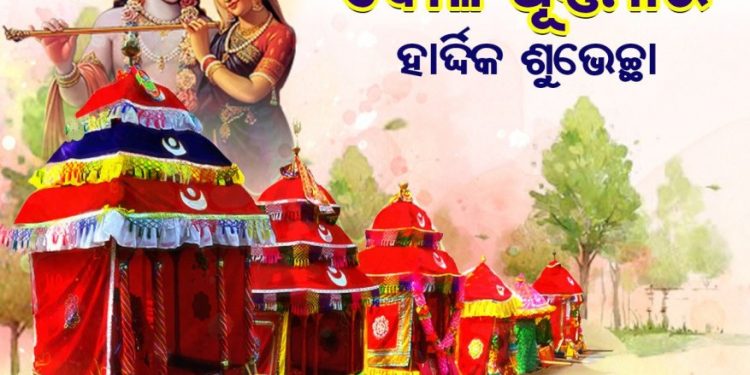Bhubaneswar: Chief Minister Naveen Patnaik Thursday wished the people of the state in view of the Dola Purnima festival. The CM expressed hope that this festival of brotherhood will bless every family with prosperity and happiness.
He took to his twitter handle and wrote: “Pabitra Dola Purnima Upalakhe Rajya Basinku Mara Hardik Subhecha aau Subhakamana. Dola Gobdinaka Apar Krupa aau Ashirbad Samastanka Jibanare Sukha, Samrudhi Bharideu.”
On the other hand, netizens across the state observed the festival with full fervour. The festival referred to as ‘Basantotsaba’ or the spring-festival in mythology is observed on the full moon day in the month of Faguna (March).
ପବିତ୍ର ଦୋଳ ପୂର୍ଣ୍ଣିମା ଉପଲକ୍ଷେ ରାଜ୍ୟବାସୀଙ୍କୁ ମୋର ହାର୍ଦ୍ଦିକ ଶୁଭେଚ୍ଛା ଓ ଶୁଭକାମନା। ଦୋଳଗୋବିନ୍ଦଙ୍କ ଅପାର କୃପା ଓ ଆଶୀର୍ବାଦ ସମସ୍ତଙ୍କ ଜୀବନରେ ସୁଖ, ସମୃଦ୍ଧି ଭରିଦେଉ। pic.twitter.com/UGcQ9EUZ3b
— Naveen Patnaik (@Naveen_Odisha) March 21, 2019
History of Dola Purnima
There was a demon king, Hiranyakashyap. He was so egoistic that he commanded everybody in his kingdom to worship him.
But his son Prahlad became an ardent devotee of Lord Narayana and refused to worship his father. Hiranyakashyap tried several ways to kill his son Prahlad but Lord Vishnu saved him every time. Finally, he asked his sister, Holika to enter a blazing fire with Prahlad in her lap.
Hiranyakashyap knew that Holika had a boon, whereby, she could enter the fire unscathed.
Holika had to pay the price of her sinister desire with her life. Holika was not aware that the boon worked only when she entered the fire alone. Prahlad, who kept chanting Vishnu Nama all this while, came out unharmed, as the Lord blessed him for his extreme devotion.
Thus, Holi derives its name from Holika and is celebrated as a festival of victory of good over evil.
Dola Jatra
In Dola Jatra, the idol of Lord Krishna is carried to all the homes in the village on a decorated Vimana (palanquin) in a procession with Sankirtan Mandali, drummers, singers and musicians.
Each household in the village offers Bhog to Lord Krishna. The people who follow the procession play with Abira (dry colours). The six-day Dola Jatra concludes on Dola Purnima.
On the final day of the Purnima, the celebration culminates with a swing-festival for the deities.
Dola Purnima
Dola Purnima marks the end of a six-day swing festival of Radha and Lord Krishna. On Dola Purnima, the idols carried in palanquins from many villages assemble in one place called Melana Padia. All the swings are fixed on one platform. The procession is led by village drummers, pipers and the ‘Sankirtana Mandalis’.
In mythology, this festival has been referred to as ‘Basantotsaba’ or the spring-festival. Some scriptures testify that ‘Madanotsaba’, the festival held in honour of ‘Madana’ or Cupid, was later transformed to “Dolatsaba” or swing-festival of Krishna.
This festival marks the onset of spring and is celebrated with fervour.
PNN







































